We’ve all seen that little dashboard icon pop up—the one that looks like a fountain spraying water onto a windscreen. That symbol is your car politely letting you know:
"Hey, it’s time to top up your washer fluid!"
Sometimes we know exactly what to do. Other times? Not so much. Luckily, most modern cars are smart enough to give you a heads-up before things get messy.
In this post, we’re breaking down what the screen wash symbol means, what to do when it shows up, and other useful FAQs to help keep your windscreen (and your driving record) squeaky clean.
What Is the Screen Wash Symbol?
The screen wash symbol usually looks like a windscreen with water droplets spraying upwards. The washer fluid reservoir cap typically carries this symbol—it’s usually colored blue and pulls off rather than twists.

What Is the Washer Fluid Warning Light?
The washer fluid warning light appears on your dashboard when your washer fluid is running low. It’s typically an amber or yellow light that resembles the screen wash symbol. The exact design may vary depending on your car's make, but the message is always the same: your washer fluid reservoir needs a refill.
To top it up, locate the washer fluid reservoir under your car’s bonnet. Look for the blue cap with the same symbol.

The Real Cost of Ignoring the Screen Wash Light
You might think driving around with the screen wash warning light on isn’t a big deal—but ignoring it can lead to more than just a dirty windscreen.
1. Visibility Issues
-
According to Transport for London, city air—especially in places like London—contains pollutants that create a stubborn film on your windscreen. Ignoring the screen wash light in urban areas could put your visibility at serious risk.
-
Sun glare on a dirty windscreen can increase your reaction time by 1.4 seconds, which could mean the difference between stopping safely and having an accident. And if you’re driving at night, it’s even worse—ROSPA reports that dirty windscreens can reduce night-time visibility by up to 50%.
2. Fines & Penalties
-
Driving with an empty washer fluid reservoir can result in a fine of up to £1,000 under the Road Vehicles Regulations (1986).
It’s also an MOT failure, meaning more hassle, downtime, and potential retesting costs. -
To avoid getting caught out, it helps to keep a high quality screen wash on hand—one that cuts through grime quickly, eco friendly screen wash tablets does this effectively with their powerful biosurfactants.
Is It Safe to Drive With Low Washer Fluid?
The simple answer: No. Definitely not.
It’s not just about being able to clean your windscreen—UK law requires your washer system to be functional. So when that light comes on, top it up as soon as you can.
Why Won’t My Washer Fluid Light Turn Off?
If you’ve refilled your washer fluid and the light still won’t go away, here are a few possible reasons:
-
Faulty Fluid Level Sensor: The sensor might be stuck or malfunctioning. The culprit sometimes is due to the foil from the bottle cap falling off nd ending up in the reservoir.
-
Dirty Contacts: Over time, the sensor’s contacts may become corroded or dirty, leading to false alerts.
If your screen wash light issue persists, your local mechanic can help sort it out.
FAQ
Where Do You Put Screen Wash?
Pop the bonnet and look for a cap with a windscreen and water spray symbol—usually blue. That’s your washer fluid reservoir. If it’s tricky to find, check your owner's manual.
How to Fill Washer Fluid — Quick Steps:
-
Turn off your engine and open the bonnet.
-
Locate the washer fluid reservoir (usually translucent, with the screen wash symbol).
-
Remove the cap, pop in your screen wash tablet, and dilute with 5L of tap water.
-
Secure the cap, close the bonnet, and test your wipers.
-
Wipe off any spills as needed.
Final Thoughts on the Screen Wash Symbol
When the screen wash symbol lights up on your dashboard, it’s your car’s way of telling you the washer fluid is running low. Don’t ignore it—topping up your screen wash is one of the easiest and most affordable ways to keep your windscreen clear, and your driving safer. It saves you from the frustration of squinting through a dirty windscreen while your wipers swipe back and forth—with nothing to clean!

